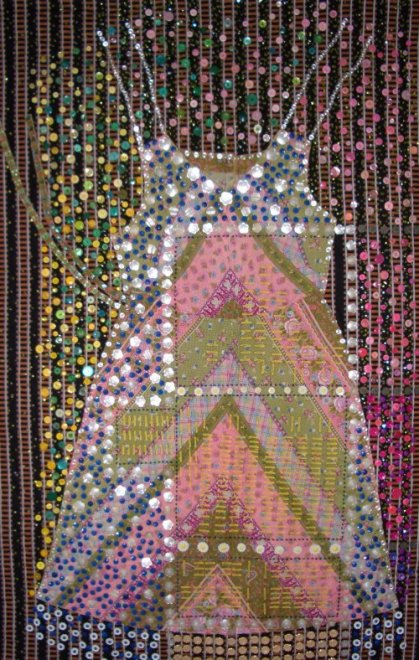 "Hope Dies Last"
"Hope Dies Last" "Hope Dies Last"
"Hope Dies Last"
On January 20th 1988, I cried a river when my beloved mother-in-law Rivka
Tauber Weiss (1928-1988) was laid to rest. It was a rainy day but the sun came
out between the clouds. That was the essence of her – even on the gloomiest
day she tried to smile. She loved me like the daughter she never had, so
losing her felt like losing a mother.
In 1944, on her 16th birthday, Rivka was transported from Kluj, Hungary to
the infamous Auschwitz-Birkenau death camp in Poland. At the gate, her parents
were immediately sent to their deaths. She then was left with nothing but the
dress she was wearing and HOPE. On May 9, 1945 she was released and lived to see
the railway to the camp covered with weeds and flowers.
On the quilt are 400 yellow buttonholes cut into a dress of Rivka’s. They form a blueprint of Auschwitz-Birkenau. Each of the buttonholes stands for a barrack representing the hurt, the tear in the fabric of society. You can never entirely “fix” or bring closure to a buttonhole. It’s always there…just as the trauma and the memories were always with Rivka, who never gave up HOPE.
"התקוה מתה אחרונה"
ביום הולדתה השש עשרה, 1944 נכנסה רבקה וייס חמותי למחנה הריכוז אשוויץ- בירקנאו ומאז נשאה את אושוויץ כל חייה. את דגם המחנה הזה העתקתי לשמלתה הפרחונית. כל ביתן מכ- 400 הביתנים היה ללולאה צהובה, חתך בבד, קרע שלא ניתן לאיחוי מושלם. מסביב לדגם המחנה תפורים מאות כפתורי פרחים כחולים ולבנים . כל זאת על רקע בד עם הדפס פסי רכבת ההולך ומתכסה בעשב ופרחים כשבראשי מהדהד השיר של אבנר טריינין "בחזרה לאשוויץ".
בצירוף מיקרים מופלא, התקשרה אלי בחורה ממגמת קולנוע שהופנתה אלי כשחפשה אמנית שיוצרת בחומרים מעניינים (כפתורים, לולאות ולבירינתים..) כשהתענינה בביקור בסטודיו תארתי את העבודה וכשהיגעתי לשיר של אבנר טריינין ציינתי שסביר שהיא לא מכירה אותו..ז"א את השיר...היא דווקא כן מכירה. את השיר ואת אבנר טריינין. הוא סבא שלה….
מה ההסתברות שמתוך 6 מיליון תתקשר אלי הנכדה בדיוק בשבוע שאני מגישה את העבודה….